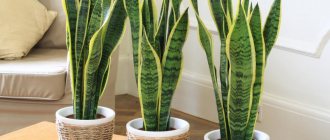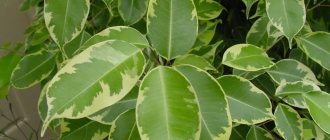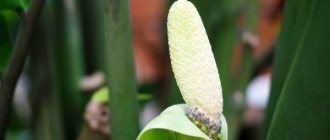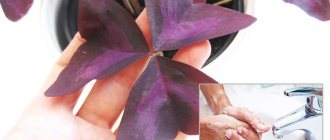Folk beliefs associated with indoor plants
- According to popular belief, cissus is a muzhegon plant. In other words, it is believed to be capable of driving men out of the house. Representatives of the stronger sex feel uncomfortable and insecure in the room where the birch tree is located. Therefore, they try to leave the territory protected by a plant hostile to them as soon as possible. Another superstition supports this belief, but adds details that a woman who keeps a cissus in her house will be constantly cheated on by her partners.
- For a married woman, a birch tree in the house means separation from her beloved man, divorce, but it is not recommended for young girls of marriageable age to keep cissus. The sign says that this plant will doom its unmarried owner to loneliness.
- On the other hand, it is believed that indoor birch gives its owners inspiration, a sense of beauty, new ideas and the desire to create.
- In addition, cissus promotes recovery, improves overall well-being, and elevates mood.
- The plant also cleanses the energy space of the home, harmonizes it, helps get rid of envy and resentment, and relieves tension between household members.
Birch flower - signs and superstitions
An unpretentious, fast-growing and very pretty home flower, the birch tree is one of the types of cissus. It compares favorably with many other “bindweeds”.
- The first thing to note is that talk about his “vampiric essence” is pure myth.
The juice of this decorative indoor vine does not contain any dangerous substances, but it contains phytoncides - special substances that can “in the bud” suppress the proliferation of pathogenic bacteria.
- Is it possible to keep a birch flower at home? Signs assure that this will only benefit all household members.
Rhomboid cissus will begin to exert its disinfecting effect day after day, cleaning the atmosphere of the home from dangerous microorganisms.
- In such a room you can breathe more freely, sleep better and think better!
- Residents of the apartment have increased immunity, digestive problems disappear, and allergic reactions and headaches are less likely to occur.
Is it possible to keep the plant in the house?
Signs and superstitions associated with indoor birch are extremely contradictory. Each lover of house plants will have to decide for himself whether it is worth keeping cissus in the house.
Benefit
If you listen exclusively to positive superstitions, then indoor birch is an excellent plant to keep in the house .
Her presence will help establish warm and trusting relationships between family members and other relatives, and will reduce the number of quarrels and conflicts. Cissus has a beneficial effect on the atmosphere in the home, filling it with lightness, harmony, warmth and comfort.
The birch tree will attract inspiration, new original ideas and opportunities for realizing potential into the home of creative individuals.
How can it be dangerous?
Impressionable women and girls who are overly concerned about their personal lives are not recommended to keep an indoor birch tree in the house. According to some beliefs, this plant drives men away from home. In order not to risk your relationship with your loved one or not be afraid of being alone for life, it is better to get another flower that is more friendly to the stronger sex.
Diseases and pests of cissus
Like all plants, indoor grapes can be attacked by various pests and also get sick. Often some cissus diseases arise from improper care. For example, a plant
- flooded;
- overdried;
- air temperature is too low;
- unsuitable soil.
But the most dangerous pests remain spider mites and leaf aphids. To destroy them, it is recommended to use special preparations.
Feng Shui meaning
According to the Eastern teachings of Feng Shui, cissus symbolizes wisdom and life experience . The plant can give the owner self-confidence, determination and perseverance.
It is believed that a person in whose house an indoor birch tree grows is more open to knowledge and skills than others, remembers new information better and faster, and strives to comprehend and understand the world around him.
In addition, owners of cissus trees cope more easily with everyday problems and life's troubles.
Reproduction
Cissus is a plant that can be propagated in several ways:
- seeds;
- cuttings;
- dividing the bush;
- layering.
Seeds
The seeds that give the best germination belong to the arctic cissus.
- From April to May they are sown in flat round pots, planted shallowly in the ground.
- The bowls are covered with a plastic bag.
- Ventilate and keep moist.
- When the sprouts have a pair of leaves, they are planted in separate pots.
The conditions for the growth of young plants are the same as for adults.
Cissus seeds can also be germinated in peat tablets
Cuttings
Propagation using cuttings is perhaps the most popular method. Moreover, the cuttings take root well both in water and in soil mixture.
- To obtain a new plant, use a sharp knife to cut a cutting 10 cm long with several leaves.
- In a small (8 cm) pot filled with a sand-peat mixture, 3 or 4 cuttings are planted at once.
- The planting container is covered with a glass jar or bag and kept at a temperature of 20 to 22 ° C and at high humidity.
The place should be bright, but without direct sun.
- After 3 weeks, roots appear and the plants are planted in separate pots. But you can plant several rooted cissus in one container. And then the plant will grow more magnificent.
Cissus can be propagated using cuttings at any time of the year, but preferably in spring or summer.
In water, cuttings root at a temperature of 14–18°C.
Dividing the bush
This method is used in the spring, when transplanting an overgrown plant into a new container. The cissus removed from the pot is divided very carefully into the required number of parts, each of which must have a formed root system and an adult shoot.
This way the cissus can be divided during transplantation.
Immediately after division, each part is planted in a separate prepared pot.
By layering
You can propagate cissus using layering at any time.
- Select an adult healthy shoot, which is fixed in a nearby pot in suitable soil.
By deepening the shoot in several places, you can get several new plants.
- As soon as the rooted shoot has grown a root system, it is cut off from the mother plant.
Cissus can also be propagated by layering
Where is the best place to place the cissus?
- If quarrels often break out in the family, and it is difficult for household members to listen and understand each other, the birch tree should be placed in the room where all family members usually spend their free time, for example, in the living room or kitchen.
- A pot of cissus in a schoolchild or student’s room will help him quickly absorb large amounts of material being studied.
- People associated with art are advised to keep a birch tree near their desk or other place where they are creative. The plant will provide an influx of fresh ideas and creative thoughts.
- If someone in the house is sick, you should keep a pot of cissus in the sick person’s room. The plant will take away negative energy and help the person recover faster.
Indoor birch is an interesting and unpretentious plant that can decorate any home with its presence. As for beliefs and signs, each person decides for himself whether to take them into account or not. But still, it is better for overly superstitious people to refuse to keep flowers in the house, the properties of which are said not only to be good. Otherwise, instead of pleasant communication with a green friend, only fears and anticipation of negative events await.
Caring for cissus at home. Details
Despite the fact that the plant is considered unpretentious, to successfully care for cissus at home, you need to comply with some requirements.
Bloom
The cissus flower practically never grows at home. The plant is valued for its fast growth, beautiful color and rich foliage.
Grown as an ornamental foliage.
Temperature
Different types and varieties of cissus differ in their requirements for optimal temperature. However, the general conditions correspond to indoor conditions.
Keeping in mind the tropical origin of the plant, for most varieties in the summer you need to maintain a temperature of 21-25 ° C. Excessive heat should not be allowed.
In winter, homemade cissus is kept at a temperature not lower than +8-12 °C. The main enemies of the plant during this period are dry air, overflow and drafts.
Important! For the heat-loving cissus variegated, the temperature in winter should not fall below +16°C.
Spraying
Since cissus is a tropical plant, it needs to create high air humidity. This is achieved through regular spraying over the entire leaf area and around the plant. Typically, spraying is carried out every week, more often in the summer heat.
They are guided by the weather and the condition of the plant. The colorful cissus species requires daily misting to maintain a constantly moist atmosphere around the leaves.
Advice! Cissus loves warm showers. Swimming can be done both in winter and summer. During the procedure, you need to ensure that the soil does not become waterlogged (cover the pot with polyethylene).
Lighting
The choice of location in the apartment depends on the variety and type of plant.
Thus, rhombifolia cissus (c. rhombfolia) is extremely unpretentious and grows both in the sun and in partial shade. Withstands even the worst lighting conditions. Antarctic cissus (p. antarcrica) is more demanding and needs diffused light, but feels comfortable in partial shade. Bright diffused light is obtained if you move the pot with the plant 1.5 m from the sunny window. The most delicate and sensitive to light is the multi-colored species. It should be placed strictly in partial shade, protected from direct sunlight. Ideal placement is western and eastern windows or 1.5-2 m from a sunny southern window.
Watering
All varieties and species have many leaves that continuously evaporate moisture.
This means that at home, cissus needs constant watering. Not only in summer, but also in winter, when the plant suffers from dry room air. In spring and summer, during periods of rapid growth, water frequently as the soil dries out. In hot weather, watering can be daily. In winter, they focus on the condition of the soil. During this period, watering is reduced to once every 2-3 weeks.
In winter, you need to especially carefully monitor the quality of watering. In cold weather, the soil dries out more slowly, and overwatering can cause serious root rot and even death of the plant. In this case, the seedling can only be saved by transplanting it into new dry soil and adding fungicides.
Cissus pot
As with other indoor plants, the pot is selected according to the volume of the root system. The walls of the pot should be 1.5-2 cm away from the earthen ball. For young seedlings, a container with a diameter of 9 cm is sufficient. For each transplant, take a larger pot. An adult plant is grown in containers with a diameter of about 30 cm.
Advice! The pot must have a drainage hole to allow excess moisture to escape.
Since cissus are climbing vines, it is necessary to think in advance about how they will be grown. For ampel forms, choose pots on high pedestals or in hanging flowerpots. For vertical gardening, a system of additional supports and lattice screens will be required.
Soil for cissus
No special soil is needed for successful cultivation. A universal one from the store will do. You can also prepare the soil yourself. To do this, you need to take leaf and turf soil, sand, peat and garden soil in a ratio of 2:1:0.5:1:1. The main condition is that the resulting substrate must be air and water permeable. To improve these qualities, vermiculite or perlite is added to the soil.
Feeding and fertilizer
Due to its active growth and large leaf mass, cissus needs regular feeding. Universal liquid fertilizer for decorative deciduous plants is applied along with watering. Dosage and frequency depend on the recommendations of the fertilizer manufacturer.
Standard advice is 1 feeding every 2-3 weeks. Fertilizers are not applied in winter.
The plant does not need fertilizers for the first months after transplanting into new soil. The nutrients available in the soil are enough for him.
Cissus transplant
All necessary transplants are carried out using the transfer method: the plant is carefully removed from the old pot along with the earthen lump and, without shaking, placed in a new container.
The voids formed near the walls are filled with soil. The frequency of transplants depends on the age and growth rate of the cissus. A young seedling needs a new pot of larger diameter every six months. At the age of 3 years and older, cissus is grown in one pot for 3-4 years or more. With regular fertilizing, in this case it is enough to simply replace the top layer of soil annually.
Trimming
Spring pruning and pinching of shoots causes additional branching. This operation is carried out to form a beautiful thick crown. In addition to decorative pruning, it also has a sanitary function: all wilted, diseased or pest-affected shoots are immediately removed.
Rest period
In a greenhouse, the plant is not deciduous and does not have a pronounced dormant period . When kept indoors, cissus multicolored can shed its leaves in the winter and grow new ones in the spring. When maintaining, you must observe the recommended temperature for each season.
Growing cissus from seeds
Antarctic and quadrangular cissus (c. quadrangularis) are grown in this way.
- Seeds are sown in spring in a loose substrate (peat, sand).
- The soil is moistened.
- The crops are covered with a transparent lid or glass and left in a warm room at a temperature of +21-25 oC.
- The container is periodically ventilated and the soil is kept moist.
- Shoots appear unevenly over 1-4 weeks.
- At the stage of 2 true leaves, they are picked into separate pots with a diameter of 5-7 cm.











